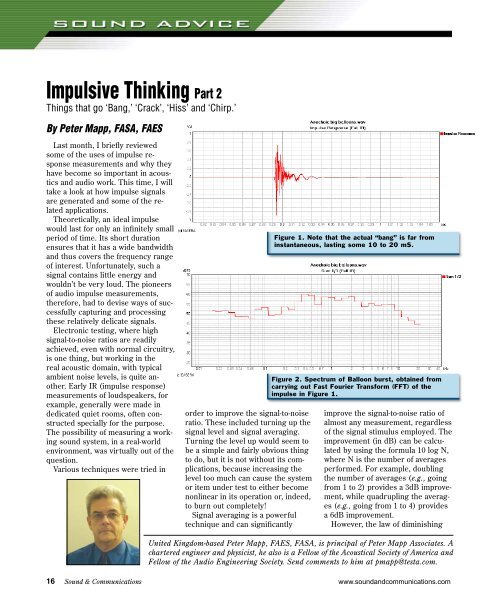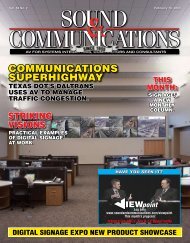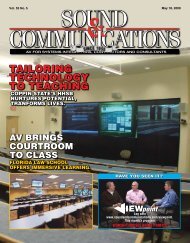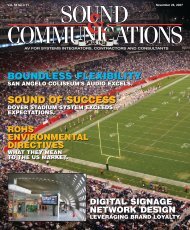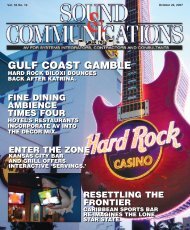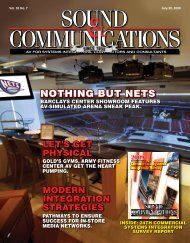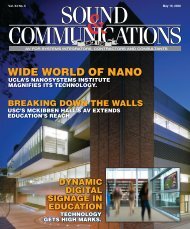Impulsive Thinking Part 2Things that go ‘Bang,’ ‘Crack’, ‘Hiss’ and ‘Chirp.’By Peter Mapp, FASA, FAESLast month, I briefly reviewedsome of the uses of impulse responsemeasurements and why theyhave become so important in acousticsand audio work. This time, I willtake a look at how impulse signalsare generated and some of the relatedapplications.Theoretically, an ideal impulsewould last for only an infinitely smallperiod of time. Its short durationensures that it has a wide bandwidthand thus covers the frequency rangeof interest. Unfortunately, such asignal contains little energy andwouldn’t be very loud. The pioneersof audio impulse measurements,therefore, had to devise ways of successfullycapturing and processingthese relatively delicate signals.Electronic testing, where highsignal-to-noise ratios are readilyachieved, even with normal circuitry,is one thing, but working in thereal acoustic domain, with typicalambient noise levels, is quite another.Early IR (impulse response)measurements of loudspeakers, forexample, generally were made indedicated quiet rooms, often constructedspecially for the purpose.The possibility of measuring a workingsound system, in a real-worldenvironment, was virtually out of thequestion.Various techniques were tried inorder to improve the signal-to-noiseratio. These included turning <strong>up</strong> thesignal level and signal averaging.Turning the level <strong>up</strong> would seem tobe a simple and fairly obvious thingto do, but it is not without its complications,because increasing thelevel too much can cause the systemor item under test to either becomenonlinear in its operation or, indeed,to burn out completely!Signal averaging is a powerfultechnique and can significantlyFigure 1. Note that the actual “bang” is far frominstantaneous, lasting some 10 to 20 mS.Figure 2. Spectrum of Balloon burst, obtained fromcarrying out Fast Fourier Transform (FFT) of theimpulse in Figure 1.improve the signal-to-noise ratio ofalmost any measurement, regardlessof the signal stimulus employed. Theimprovement (in dB) can be calculatedby using the formula 10 log N,where N is the number of averagesperformed. For example, doublingthe number of averages (e.g., goingfrom 1 to 2) provides a 3dB improvement,while quadr<strong>up</strong>ling the averages(e.g., going from 1 to 4) providesa 6dB improvement.However, the law of diminishingUnited Kingdom-based Peter Mapp, FAES, FASA, is principal of Peter Mapp Associates. Achartered engineer and physicist, he also is a Fellow of the Acoustical Society of America andFellow of the Audio Engineering Society. Send comments to him at pmapp@testa.com.16 <strong>Sound</strong> & <strong>Communications</strong>www.soundandcommunications.com
Figure 3a. Log Sweep Signal.Figure 3b. Zoomed Log Sweep Signal.Figure 4. Sweep signal when picked <strong>up</strong> in test room.Note how different this is to the input signal.realized that these signals are notimpulsive, but are either steady stateor pseudo-steady state sounds thatwould appear to bear no resemblancewhatsoever to an impulse. Deadright! But this is where the power ofthe modern PC and some nifty mathematicsstep in and, by the processof convolution or, actually, de-convolution,transform the test signal intoits equivalent impulse. The beautyof these signals is that, not only arethey highly repeatable, but they arereasonably noise immune—particularlywhen averaged a few times.The most robust of these, by far,is the log sine sweep. I have madehighly successful acoustic measurementsusing this form of sweep withvacuum cleaners operating in theaged.(See Figure 1 for the anechoictime response of a balloon burst andcorresponding energy content as afunction of frequency).Precision measurements requirethe use of a repeatable electronicsignal. Spark generators are usedfor some specialist applications suchas microphone testing and acousticscale model work, though, again,there can be a degree of variationbetween “zaps” or “cracks.” Themost commonly used test signalsemployed for impulse response measurementstoday are sine sweeps, logsweeps, Maximal Length Sequences(MLS) and pseudo-random noise,i.e., pink and white noise.Now, faster thinkers among youreading this will have immediatelyreturns soon sets in, so, going from,say, 10 averages (a 10dB improvement)to 20 averages would only producean additional 3dB improvement(i.e., 13dB). To gain a further 10dBof improvement would require afurther tenfold increase, or a total of100 averages, in this case to achievean overall improvement of 20dB.Now, although this may well bepractical for the laboratory testing ofloudspeakers, it is not a viable propositionwhen testing a sound systemor for measuring room acousticparameters. Not only might the testduration become excessive, but localvariations and fluctuations in theacoustic environment that occur inalmost any large room or space mayaffect the resultant answer. Clearly,a different technique/test signal isrequired. Enter bangs, chirps, andhisses and buzzes.Simple acoustic measurements ofreverberation time, sound decay oreven echo reflection structures canbe made using a relatively crudemechanical impulse such as that obtainedfrom a balloon burst, gunshotor mechanical impact. A significantproblem with this type of stimulus isthat every individual impulse can be(and usually is) quite different fromthe next. Therefore, such testingcannot be used to look at the finestructure of reflection sequences,and a number of impulses must beused and the processed results aver-September 2008 17
- Page 1: Vol. 54 No. 9 September 22, 2008AV
- Page 4 and 5: Volume 54 Number 9 September 22, 20
- Page 6 and 7: Our theme this month, Entertainment
- Page 8 and 9: EXPERIENCE MORE .: CONFIDENCE :.Eve
- Page 10 and 11: NEWSLETTERmance standards and our c
- Page 12 and 13: A Cheerful Hello and a Warm Shake.T
- Page 14 and 15: Digital Signage: Not the Next Big T
- Page 18 and 19: aters and conference rooms, or with
- Page 20 and 21: Finding Your Own TalentSome comment
- Page 22 and 23: Maintaining Intimacy Maximizes The
- Page 24 and 25: systems, which included distributed
- Page 26 and 27: flections and tamed the acoustics f
- Page 28 and 29: ecause audio, video and lighting co
- Page 30 and 31: Youth MinistryReaching young people
- Page 32: Predator Under The Surface Part 2So
- Page 35 and 36: September 2008 35
- Page 37 and 38: All Photos: Christopher LudwigThe T
- Page 39 and 40: September 2008 39
- Page 41 and 42: September 2008 41
- Page 43 and 44: A Personal PerspectiveThe museum’
- Page 45 and 46: MEGA PERFORMANCE.MICRO SIZE.The new
- Page 47 and 48: September 2008 47
- Page 49 and 50: NAI48-ES can connect to as many as
- Page 51 and 52: As with many venues in New York Cit
- Page 53 and 54: ole in the process: “David Handle
- Page 55 and 56: The DX Series is the proven, future
- Page 57 and 58: MM-4XP compact speakers also provid
- Page 59 and 60: Far out.Kramer’s line of Cobra C
- Page 61 and 62: Two 40-inch panels in the Superpowe
- Page 63 and 64: September 2008 63
- Page 65 and 66: tage of the seven sets,” explaine
- Page 67 and 68:
Multi-zone Program and Paging Manag
- Page 69 and 70:
During the Opening Ceremonies,Arnol
- Page 71 and 72:
The Simpsons ride’s four digital
- Page 73 and 74:
Mad Systems is banking on clientsse
- Page 75 and 76:
for an Alien Invasion slide complex
- Page 77 and 78:
a controlled environment.” The re
- Page 79 and 80:
ers and displays. We’ll also expl
- Page 81 and 82:
What’s required is a system in wh
- Page 83 and 84:
s Architectural Acoustics’ PHRSer
- Page 85 and 86:
s MC 2 Audio’s Ti Series Network
- Page 87 and 88:
s RapcoHorizon’s LTI-1Stereo Inte
- Page 89 and 90:
Displaysfor sports barss Audio-Tech
- Page 91 and 92:
s Renkus-Heinz’sComplete Sygma Li
- Page 93 and 94:
thiS month onThe industry’s first
- Page 95 and 96:
s RadioCom’s BTR-80N Wireless Int
- Page 97:
sElectro-Voice’s PL Series Micss
- Page 101 and 102:
model 112IM/70 all-weather loudspea
- Page 103 and 104:
at the maximum per-share price of $
- Page 105 and 106:
AN ADVERTISING SUPPLEMENT TO SOUND
- Page 107 and 108:
AN ADVERTISING SUPPLEMENT TO SOUND
- Page 109 and 110:
FURNITURE, ROLLTOP DESKS AND RACKSS
- Page 111 and 112:
SUPPLIERSEMPLOYMENTElectronic Desig
- Page 113 and 114:
SUPPLIERSMarketplace Ads WorkCall L
- Page 115 and 116:
AtlasSolutionsAA120M ampsare UL Lis


